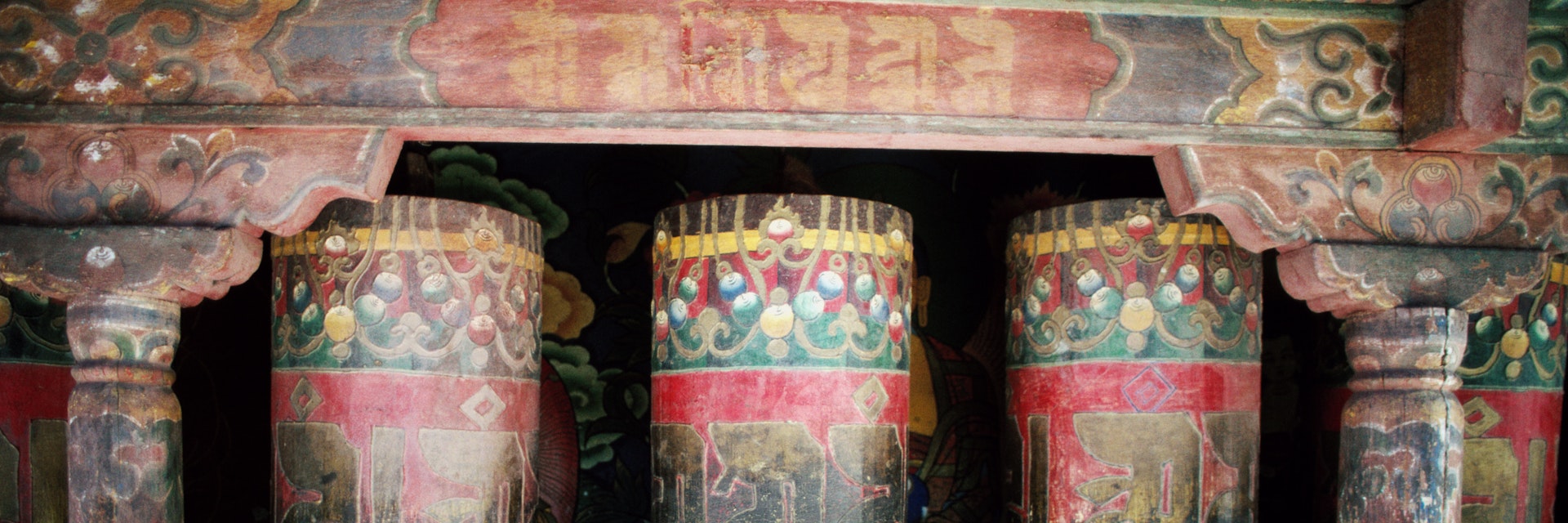The immense, grey, thick-walled southern monastery is one of Tibet’s most impressive constructed sights, and one of the largest monasteries – home to about 200 monks. Established in 1268, it was designed defensively, with watchtowers on each corner of its high walls. Inside, the dimly lit hall exudes a sanctity and is on a scale that few others can rival. Morning is the best time to visit as most chapels are closed over the lunch period.
Directly ahead from the east-wall main entrance is the entry to the inner courtyard and then the main assembly hall (Lhakhang Chenmo or Tsokchen Dukhang), a huge structure with walls 16m high and 3.5m thick.
At first glance the assembly hall may strike you as being like most others in Tibet: a dark interior illuminated with shafts of sunlight and the warm glow of butter lamps; an omnipresent smell of burning butter; and an array of gilded statues representing buddhas, bodhisattvas, Tibetan kings and lamas. But even weary tour groups seem to quickly recognise the age, beauty and sanctity of Sakya. Plan to spend time just soaking up the sacred, medieval atmosphere. You’ll find few that are its equal.
A few things to look specifically for in the hall are the huge drum in the far left corner and the massive sacred pillars, some of which are made of entire tree trunks and are famous throughout Tibet. One reputedly was a gift from Kublai Khan.
Another gift from Kublai to the monastery is Sakya’s famous white conch shell, which was brought from India and currently sits in a gilded mandala-shaped box in the centre of the hall. Pilgrims queue to hear the soft, low sound of the sacred conch being blown by an attendant monk.
The walls of the assembly hall are lined with towering gilded buddhas, which are unusual in that many also serve as reliquaries for former Sakya abbots. The buddha in the far left corner is said to enshrine a tooth of the Buddha. The large nearby chörten is the funeral stupa of the monastery's 40th abbot; the statue to the right of this houses the tooth of Sangye Wosum, the primordial Buddha. The central Sakyamuni statue enshrines the clothes and relics of Sakya Pandita, though the head monk told us that it also holds the golden turds of Guru Rinpoche that turned into a conch. To the right of the central buddha are statues of Jampelyang (Manjushri), a seated Jampa (Maitreya) and a Dorje Chang (Vajradhara).
Sakya’s famous library, long considered the greatest in Tibet, is also accessible from this hall and worth a visit for its floor-to-ceiling collection of around 24,000 texts comprising 8848 reams of scripture. The huge manuscript displayed at the end is written in gold and is 800 years old – the largest and longest scripture in Tibet.
As you exit the assembly hall the chapel to the right (south) is the Phurbu Lhakhang, named for the ancient four-faced metal phurbu displayed in a 3D mandala and taken out once a year. Central images are of Sakyamuni (Sakya Thukpa) and Jampelyang (Manjushri), while wall-sized murals behind depict Tsepame (Amitayus) to the left, Drölma (Tara) and white, multi-armed Namgyelma (Vijaya) to the far left, as well as a medicine buddha, two Sakyamunis and Jampa (Maitreya). The giant puppets in the corners are used in annual cham (ritual dance) in the 11th Tibetan lunar month.
To the north of the inner courtyard is the Nguldung Lhakhang containing 11 gorgeous silver chörtens, which are also reliquaries for former Sakya abbots. Look to the left corner for the sand mandala inside a dirty glass case. A sometimes-locked door leads into a back chapel with additional amazing chörtens and mandala murals. Bring a light source as the room is even dimmer than others.
Next door is a Relic Exhibition (admission ¥20), which contains several of the monastery's prize statues, including a leaf inscribed with a Tibetan mantra, and the hat, cup and saddle of the monastery's founder.
As you exit the inner courtyard take the entryway left to the Tsechu Lhakhang, which houses a speaking statue of Guru Rinpoche and funeral chörtens from the lineage holders of Drölma Phodrang (Sakya had two ruling houses, the Drölma Phodrang and the Phutsok Phodrang).
There are a couple of chapels open outside of this central complex (but still within the walled compound), the most interesting of which is the very spooky protector chapel of the Lhakhang Lhodrang. If the thick incense doesn’t get you, the terrifying monsters, huge cham masks and demonic yaks that wait in the dark recesses just might.
There are several other gönkhangs (protector chapels) on the top floor of the monastery, accessed by a long ladder to the side of the main entrance.
It is possible to climb up onto the outer ramparts of the monastery for a stunning kora that takes in fine views of the surrounding valley and mountains. Do not miss this.

